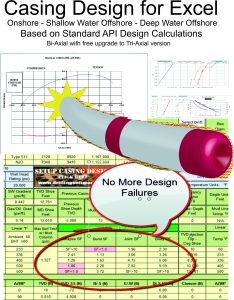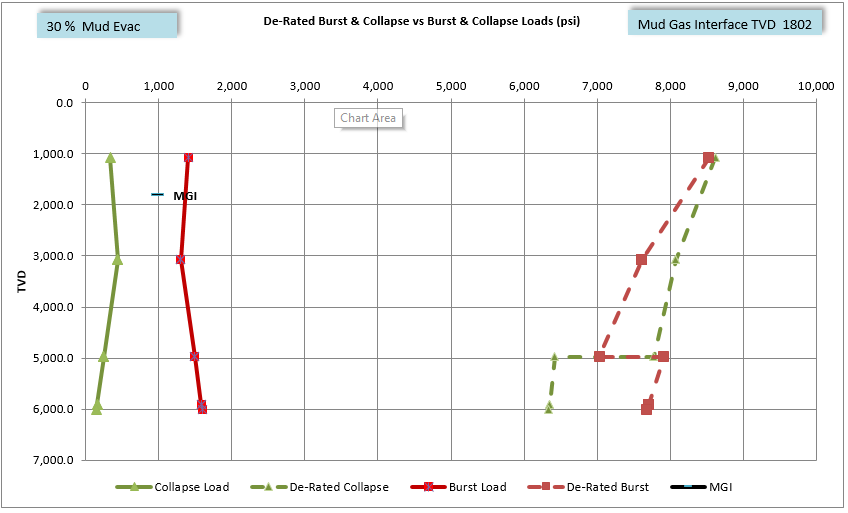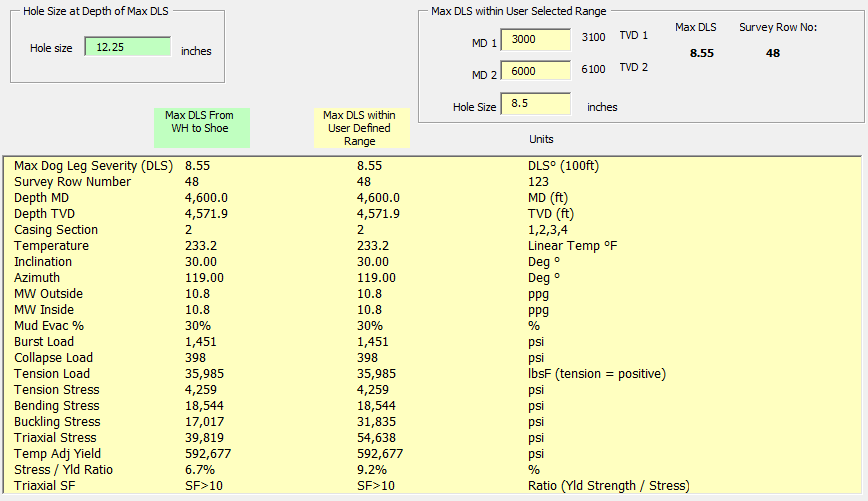
Tri-Axial Casing Design is a completely new version of casing design covering both Bi-Axial and Tri-Axial calculations for bending, collapse and tension stress changes based in the maximum dog leg severity between Well Head and Casing Shoe. Including the option to look up the maximum DLS between any selected depths MD 1 to MD 2. The program picks the maximum DLS between the user inputs.
Tri-Axial Casing Design is linked to Well Trajectory and Azimuth Closure
The program includes a database of over 4138 different joints of casing to choose from (plus the option to add custom Csg Specs)
Unlimited custom casing sizes can be added to the database with user defined casing design specifications
When you set up your design the Tri-Axial design program allows up to 4 different weights grades per section or in the case of Liner installation allows cemented in place casing and a Liner section with 3 different casing specs or 3 tapered Liners.
The program links to a full Directional and Azimuth Closure function which can be imported or input manually.
Triaxial casing design Criteria includes, Land, Shallow Offshore, Deep Water Offshore casing design
- New Cementing Safety Factors and Linear Temperatures at Lead and Tail cement tops plus Design Loads
- 100% mud evacuation for producing condition
- 0% – 100% evacuation selectable for all design conditions
- Drilling Condition
- Producing Condition
- Completely flexible with Feet or Meters for TVD and MTD
- Option of using °F or °C for both Linear and Custom Temperature inputs
- Safety Factor at Mud Gas interface at evacuation point
- Mud Gas Interface indicated on all charts and reports
- Quick view chart viewer for De-Rated Tensile results
- Quick view chart viewer for directional trajectory
- The finalized casing design reports can be emailed directly to the client
- The casing design program includes the option to export your design to a local well file
- Casing design Calculations.
- For De-rated Collapse Load Collapse curve due to axial loading
- Temperature De-rated Burst and Collapse safety factors calculated
- All safety factors calculated taking old mud or salt water behind casing into consideration.

API rated burst strength is de-rated for temperatures from 10 to 600 F° (-12 to 316 C°) Drilling Condition – Gas/oil kick while drilling below the shoe with partial or total mud evacuation (user selects evac percent), with shut in pressurized column of gas/oil to surface and old mud weight gradient behind casing. The old MW that was behind the casing when it was cemented is used for annulus hydrostatic burst calculations and the present MW is used for internal hydrostatic calculations. The user inputs the gas/oil gradient that most closely fits their design for internal pressure gradient.
API rated burst strength is de-rated for temperatures from 10 to 600 F° (-12 to 316 C°) Drilling Condition – Gas/oil kick while drilling below the shoe with partial or total mud evacuation (user selects evac percent), with shut in pressurized column of gas/oil to surface and old mud weight gradient behind casing. The old MW that was behind the casing when it was cemented is used for annulus hydrostatic burst calculations and the present MW is used for internal hydrostatic calculations. The user inputs the gas/oil gradient that most closely fits their design for internal pressure gradient.

Production Condition – 100% mud evacuation with full column of shut in pressured gas/oil to surface and salt water gradient behind casing
Drilling burst loads are calculated assuming a shut in gas/oil kick with Leak off EMW pressure at the shoe and a casing evacuation percent chosen by the user (typically 10 – 40 %).
Production burst loads are calculated assuming a full shut in column of pressured gas/oil (i.e. 100% mud evacuation), with Leakoff EMW pressure at the shoe and a column of salt water behind the casing. .
Collapse Design API rated collapse strength is de-rated for temperatures from 10 to 600 F° (-12 to 316 C°). . The temperature de-rated collapse can also be further de-rated for axial tension if desired.

Drilling collapse loads are calculated assuming the casing has been partially or fully evacuated of mud (resulting from lost circulation, or a blowout), while drilling below the shoe, with a non-pressured column of gas/oil to the surface (i.e. atmospheric pressure at the surface) and a full column of old MW behind the casing. The user inputs the gas/oil gradient that most closely fits their design for internal pressure gradient. . Production collapse loads are calculated assuming 100% mud evacuation with an un-pressured column of gas/oil to the surface. The old MW that was behind the casing when it was cemented is used for annulus hydrostatic collapse calculations. The user inputs the gas/oil gradient that most closely fits their design for internal pressure gradient.
Cementing Collapse loads are calculated with applicable hydrostatic columns of mud and cement slurries outside the casing and displacement fluid column inside the casing. The small hydrostatic difference of the cement in the shoe joints is ignored and displacement fluid is assumed to the shoe TVD. Cementing collapse is typically a concern with big OD conductors and surface casings.

Tensile Design API rated tensile strengths (body and joint), are de-rated for temps 10 to 600 F (-12 to 316 C). . Drilling and Production Casings are calculated with the same assumptions. Tensile analysis considers the total hanging weight of the casing as it is being run in the hole. The user selects Vertical or Directional tensile analysis to calculate tensile loads assuming buoyant weight of steel in a mud filled hole. . Buoyancy factor = (65.4-MW)/65.4
Vertical tensile load assumes casing hanging in a vertical hole with drag forces ignored.
Directional tensile load assumes the true vertical (TVD) length, of the casing at any specified depth (i.e. axial tensile load), with drag forces ignored. . Directional program calculates TVD’s from user input survey data.
Tri-Axial Casing Design includes a combination of csg and Liner installation, the new version of Casing Design now includes liner overlap calculations
Tri-Axial Casing Design can be linked to Well Trajectory and Azimuth Closure planned in Well Plan
The program covers both Vertical, Directional designs for On Shore, Shallow Water Offshore, Deep Water Off Shore . Feet or Meters, temperature de-rating factors, cementing safety factors Burst, Collapse, Tension Safety Factors can be API or user defined.

Well Plan trajectory can be imported into triaxial casing design


